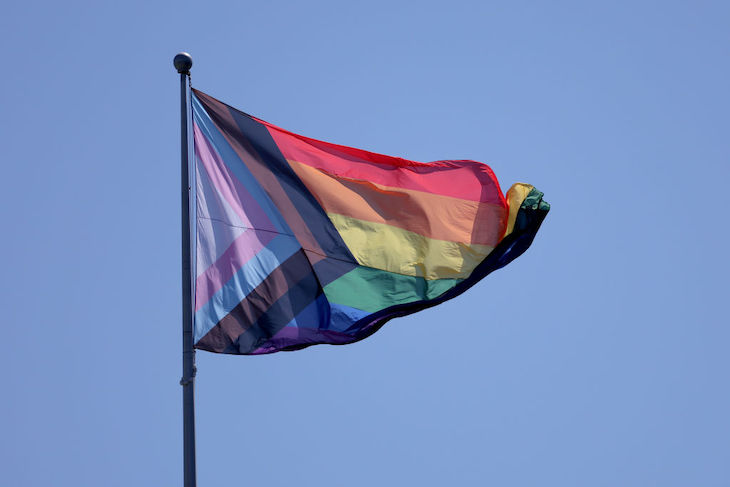For a month that’s supposed to be all about love and acceptance, Pride has a pretty nasty streak. Maybe that’s what one of the mysterious colours on its indecipherable flag represents: the cruelty community.
Consider Oxfam’s Pride animation, which it tweeted out earlier this week. Alongside all the usual Pride platitudes – we must love and respect LGBTQIA+ people, the cartoon characters say – the video went in for some Terf-bashing too.
If Pride is about love, why does it feel so intimidating?
‘Terf’ stands for ‘trans-exclusionary radical feminist’, but really it means ‘witch’. It’s a slur hurled at women who think sex is real. Who think people with penises are men, not women. You know – women who understand reality. Ready the stake!
Oxfam’s animation went from happy-clappy rainbow talk to venom and caricature with staggering speed. One minute you were watching young, cool, gender-curious people with tattoos stand up for their rights. The next you were confronted by a bitter old hag, her eyes red with loathing, her face contorted into a mask of hate.
That was the Terf. She has two equally horrible-looking blokes standing with her. As their unholy countenances appear on screen, the voiceover informs us that, in this Pride month, LGBT folk are being ‘preyed on by hate groups online and offline’.
So there you have it: ‘Terfs’ are a hate group. Women who stand up for biological truth and women-only spaces are akin to the KKK.
Women like JK Rowling. Some are speculating that Oxfam’s Terf was a grotesque caricature of Ms Rowling. Oxfam denies this. But there are certainly similarities in terms of clothing and hairstyle between its vile animated Bad Woman and real-life Rowling. This is probably what Rowling looks like in the twisted minds of misogynists who cannot bear her uppity defence of the reality and rights of womanhood.
It all felt like a Two Minutes Hate. Jeer the Terf. Behold her unsightly visage. Witness how she preys, beast-like, on the vulnerable. This is witch-finding 21st-century style.
Oxfam has paid a heavy price for its cruel caricature of dissenting women. The backlash has been so ferocious that it felt compelled to take the animation down and edit out its medieval lampooning of the hysterical woman. This is one of the great things about living on ‘Terf island’, as some trans activists refer to the UK: there are armies of women and men who valiantly call out censure and misogyny every time they make a grim appearance.
There’s a dark irony in the Oxfam controversy. The animation was ostensibly about celebrating diversity, and yet it exhibited a deep disdain for intellectual diversity; for the right to express gender-critical views.
It was a cartoon all about inclusion, but not for Terfs, not for those foul creatures. Exclusion is all they deserve. Cast them out. After all, they’re a ‘hate group’, and what do we do with hate groups in the 2020s? We silence them.
It was an animation about love, apparently, and yet it contained a vibe of hatred. Hatred for those that think differently. Hatred for those who demur from the new orthodoxies. Oxfam implies Terfs are a ‘hate group’ even as it hatefully depicts these women whose only offence is to say men are men.
These contradictions are not a glitch in the Pride system. They’re central to Pride, and to identity politics more broadly.
Pride month preaches inclusion while excluding those who offend it. Last year, gender-critical lesbians were hounded out of a Pride Cymru march in Cardiff for waving a banner that said ‘Lesbians don’t like penises’. That was a statement of fact for millennia. Now it’s ‘bigotry’.
Pride month celebrates diversity but it is hostile to diversity of belief. Witness the grief heaped on trans people who change their minds, who seek to ‘detransition’ back to their real sex. These are apostates in the eyes of some LGBT activists.
Or just witness the bile that comes gender-critical women’s way every day on the web. Much of this contempt comes from the kind of people who have the Pride flag, ‘love is love’ and, of course, their pronouns in their social-media bios.
The intolerance of Pride month is captured in the fact that anyone who refuses to mark it is likely to find themselves shamed and demonised. In 2021, Ockbrook and Borrowash Parish Council in Derbyshire was branded a sinful backwater when it refused to fly the Pride flag.
Profaning against Pride can even become a police matter. Last year, a man in Hampshire was visited by cops and put in handcuffs for tweeting a meme featuring four Pride flags arranged to look like a swastika. Thou shalt not speak ill of Pride.
This isn’t a movement for equality. It’s identitarian jingoism. The rainbow flag hangs in vast military-style formations over every boulevard in London. It flaps from the towers of every bank, every corporation, every school, every hospital. This feels like the triumphalism of the new elites, not a celebration of gay rights.
‘We’re in charge now’, they’re effectively saying with all that Pride paraphernalia. Our gender ideology, our valuation of identity over solidarity, our censorious intolerance for any woman or gay man or anybody else who dares to question our worldview – this is what rules the day now. That’s all I hear these days when I see the Pride colours conquer our communities every June.
If Pride is about love, why does it feel so intimidating? I’m tiring of the tyranny of Pride. It’s outlived its purpose. Time to scrap it.







Comments